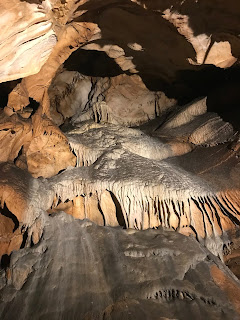Project Results
Now that I have visited all four UNESCO sites, I would like to summarize the research that I have collected throughout this trip.
My first research question was why these specific sites were added to the UNESCO Natural World Heritage List. I learned that to become a UNESCO Natural World Heritage site, there are four natural criteria. Each one of the sites that I researched met at least one of these criteria. These two were the most common: "to be outstanding examples representing significant on-going ecological and biological processes in the evolution and development of terrestrial, fresh water, coastal and marine ecosystems and communities of plants and animals" and "to be outstanding examples representing major stages of earth's history, including the record of life, significant on-going geological processes in the development of landforms, or significant geomorphic or physiographic features."
My second research question was: What is being done to preserve these sites? I learned that each country is supportive in funding and preserving their own UNESCO sites. Several declarations are signed, vowing to protect the sites. Additionally, many NGOs are influential in the preservation of these sites. However, I am still left with the question of what are these countries and organizations doing to physically protect these sites.
Another topic I researched was the effects of over population and tourism. With all four sites, over population was not an issue. These sites are often far from civilization. Small villages and single homes were along the sides of the fjords, only a few homes were around the caves in Slovakia and no homes were around the caves in Slovenia, and no one lives in the lake park in Croatia. On the other hand, tourism is an issue. These sites attract tourists from all over the world. Of course with all these tourists, the natural state of these sites would not remain the same. The fjords and both caves in Slovakia and Slovenia give tours but there are quotas on how may people can visit at once. Croatia has no quota and I think that this will eventually harm the park. I gathered that because there are many tourists that come to these sites, rules and regulations need to be enforced so that the tourists respect the natural state of the sites.
The topics of pollution and natural hazards were also researched. I was surprised to find that pollution was not a big issue at any of these parks. There was no visible pollution but there were levels of pollution in the water. The rain water that seeps into the caves and the water in the fjords and the lakes all have small levels of pollution. The levels are not high and will not do any damage. However, if these levels increase, these sites will be threatened. Natural hazards also affect these sites. The hazards vary per site and are completely unavoidable.
My first research question was why these specific sites were added to the UNESCO Natural World Heritage List. I learned that to become a UNESCO Natural World Heritage site, there are four natural criteria. Each one of the sites that I researched met at least one of these criteria. These two were the most common: "to be outstanding examples representing significant on-going ecological and biological processes in the evolution and development of terrestrial, fresh water, coastal and marine ecosystems and communities of plants and animals" and "to be outstanding examples representing major stages of earth's history, including the record of life, significant on-going geological processes in the development of landforms, or significant geomorphic or physiographic features."
My second research question was: What is being done to preserve these sites? I learned that each country is supportive in funding and preserving their own UNESCO sites. Several declarations are signed, vowing to protect the sites. Additionally, many NGOs are influential in the preservation of these sites. However, I am still left with the question of what are these countries and organizations doing to physically protect these sites.
Another topic I researched was the effects of over population and tourism. With all four sites, over population was not an issue. These sites are often far from civilization. Small villages and single homes were along the sides of the fjords, only a few homes were around the caves in Slovakia and no homes were around the caves in Slovenia, and no one lives in the lake park in Croatia. On the other hand, tourism is an issue. These sites attract tourists from all over the world. Of course with all these tourists, the natural state of these sites would not remain the same. The fjords and both caves in Slovakia and Slovenia give tours but there are quotas on how may people can visit at once. Croatia has no quota and I think that this will eventually harm the park. I gathered that because there are many tourists that come to these sites, rules and regulations need to be enforced so that the tourists respect the natural state of the sites.
The topics of pollution and natural hazards were also researched. I was surprised to find that pollution was not a big issue at any of these parks. There was no visible pollution but there were levels of pollution in the water. The rain water that seeps into the caves and the water in the fjords and the lakes all have small levels of pollution. The levels are not high and will not do any damage. However, if these levels increase, these sites will be threatened. Natural hazards also affect these sites. The hazards vary per site and are completely unavoidable.

Comments
Post a Comment